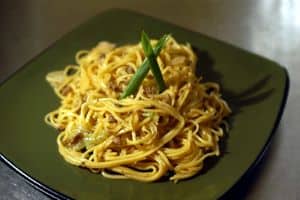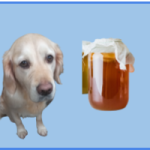Lo mein is just one of those delicious dishes that most people enjoy.
There are many ways to make lo mein, whether it’s strictly vegetables, different types of proteins, or spiced-up with all of your favorite seafood mixed-in.
But can dogs eat lo mein?
No.
There are just too many added complex ingredients such as soy sauce, onion, pepper, and salts that are not suited for dogs.
It will honestly just irritate their stomach.
But on the bright side, there are alternatives.
Feed them plain noodles in small portions.
Another option is to feed them brown rice because it’s very healthy.
The dog will be happier and more energetic making for a more comfortable and joyful dog.
What is Lo mein?
Lo-mein is one of the most universally-liked dishes.
The word lo mein is Cantonese for stirred noodles, traditionally made with thin flour and egg noodles.
The origin of Lo mein can be traced back to China, in the course of the Han Dynasty between (206 BC – 222 AD).
Noodles have always been a significant part of Chinese culture and even symbolizes a prosperous life.
Since living a long, fruitful life is highly valued in Chinese culture, it’s understandable that noodles are so essential and upheld in Chinese culture and incorporated in most dishes.
During the Chinese New Year, noodles symbolize longevity and are eaten all over China.
Even during end-of-life celebrations, noodles are placed at the gravesite.
Noodles are a prime dish for celebrating birthday parties.
When cooking the noodles, the rule is never to break a noodle.
Is it a sign of bad luck?
Who knows, but it is a rule, and swallowing without chewing is a sign of good luck.
There are two types of noodles commonly cooked, wheat and rice noodles.
Wheat noodles are primarily used in China, located in the Northern region, where the climate is colder, and therefore wheat is more of an abundance.
In contrast, rice noodles consist of white flour and water with a clear transparent color.
These rice crops grew in hot weather, in the Southern parts of China.
Interestingly enough, back in the old days, since wheat wasn’t readily available to people in the southern region, they created a method to make noodles out of rice grains.
Rice noodles can be traced back to the Qin dynasty.
Lo mein vs. chow mein- what is the difference?
To anyone that has never sat down and contemplated whether chow mein is different from lo mein, it is different and similar at the same time.
Both dishes require wheat flour egg noodles; the actual difference is the method of preparation. Lo mei is boiled to softness.
While chow mein noodles are fried to a crisp, and although there are different types of chow mein dishes, the ingredients are the same.
Proteins like meat, shrimp, pork, beef, and seafood are added to chow mein with stir-fried sauce.
Since wheat flour egg noodles are used to make these dishes, both dishes have the same nutritional value.
Chow mein is a dish that seems to have always been in existence, but its origins are entirely unknown.
Historians have pinpointed chow mein to the Northern parts of China, but no one knows for sure. Chow mein, translated from Mandarine, means fried noodles in English.
Chinese immigrants brought chow mein to the United States around the 1850s.
The stir-fried dish was infused entirely into Western culture, ultimately becoming Americanized. Thus, there are different variations different from the traditional Chinese chow mein.
It can vary depending on the additional ingredients added.
When it comes to lo mein, you can pretty much freestyle it or look up some recipes online. It is straightforward to make.
Here are some common ingredients for lo mein.
What ingredients are in lo mein:
| 8 oz of lo mein egg noodles | Carrots |
| Cabbage | Sodium soy sauce (low sodium optional ) |
| Green peppers | sugar |
| Olive oil | Ground ginger |
| Green onions | Sriracha |
| Garlic | Protein (chicken or shrimp) |
| Mushrooms | Sesame oil |
| Red pepper | Baby spinach |
Are any of these ingredients toxic to dogs?
As tasty as lo mein is for humans, most of the added ingredients in lo mein are very toxic towards dogs.
Dogs cannot eat garlic, spring onions, and open peppers.
These components can cause very types of health issues that can be pretty dangerous for your little friend.
Heavy ingredients like oil, salt, soy sauce are pretty harmful to dogs.
Their stomachs are just not built to handle those types of components.
Not to mention that salt can cause dehydration and make your dog bloated.
Even if a dog ingested a tiny amount of lo mein, it could still cause some symptoms like an upset stomach.
How healthy are egg noodles for your dog?
There are so many foods that dogs cannot eat, but they’re also a lot of foods that dogs can eat: egg noodles are one of them so long as your dog doesn’t have a gluten or wheat allergy.
Noodles are an excellent snack for dogs because noodles are made with water, wheat, and eggs are harmless to dogs.
So the next time you have leftover boiled noodles, give some to your dog.
How many noodles should you feed my dog?
You should feed your dog a small amount of noodles. Noodles are rich in carbohydrates, which is very good for dogs.
No additional ingredients necessary, just plain boiled noodles.
If you’re giving your dog noodles daily, that can add up and make them gain weight in the process. Here are some additional beneficial factors to giving your dog noodles.
Minerals like calcium and phosphorus are perfect for dogs.
Also, vitamins like A, B, D, and K are suitable for dogs as well.
Noodles should only be fed as an occasional treat, but why?
Certain types of complex carbs are perfect for dogs, like noodles and brown rice.
These carbs are a great source of an energy boost but with vitamins and minerals.
However, everything in moderation is a rule of thumb that we humans try to live by to maintain a healthy lifestyle.
Therefore, you should apply that same rule to your dog. Refrain from feeding your dog too many noodles.
However, noodles aren’t necessarily harmful to them.
Only feed your dog one cup of noodles once or twice a week because a moderate carb intake makes for a healthier lifestyle.
Never give your dog instant noodles because it’s filled with a lot of salt and added seasoning.
Egg noodles vs. Fried rice, which is better for your dog?
So we previously explained that noodles are good for dogs because they’re made with simple ingredients like egg, wheat, and water.
However, when dogs consume too much, it can be harmful to their health.
Rice and we are almost the same thing; they’re both grains from the Poaceae family. The Poaceae family is a ubiquitous monocotyledonous plant.
A glass-like flower plant.
These plants have different looks like bamboo, cereal wheat, and basal.
Some may have a woody texture.
I digress; I say all this to say since noodle and grain are in the same family, coming from the same plant species, one could presume it would be ok for dogs to eat fried rice?
Wrong, fried- rice is not suitable for dogs.
Usually, when people make fried rice, they add many oils, maybe soy sauce and spices, which are harmful to dogs.
But on a positive note, dogs can eat boiled white rice.
Nutritional benefits in rice for dogs:
Vitamins: Good for heart health Minerals: Overall Health
| Vitamin A | Magnesium | Calcium |
| Vitamin B | Potassium | Iron |
| Vitamin K | Zinc | Riboflavin Selenium |
Another terrific alternative to fried rice is white rice or brown rice.
Brown rice is the healthiest source of nutrition for your dog.
Interestingly enough, during the harvesting process, the hulls are removed from the rice leaving just the kernel; this is the best choice for your canine friend because the bran, endosperm, and germ are still enacted while brown rice is packed with all the nutritional benefits.
With refined rice or white rice, the outer layer of the rice is removed, stripping away vitamins, minerals, and fiber, making the rice less nutritious.
So by feeding your dog brown rice, he or she is getting the full nutritional benefits.
Plus, brown rice is an excellent source of protein and energy for your dog.
Brown rice is also the source of a powerful antioxidant that boosts the immune system and prevents diseases.







